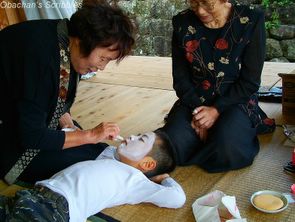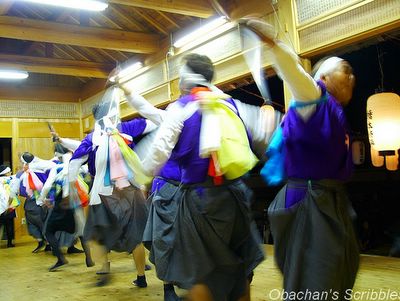Tuesday, October 31, 2006
Happy Halloween!
Pix from Halloween costume party (Saturday, Oct. 28th) @ Hirome ichiba in Kochi
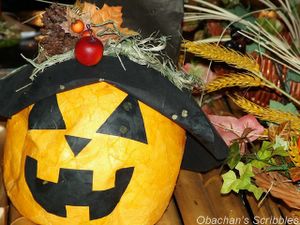

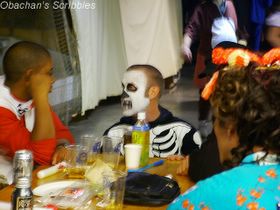
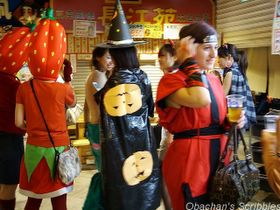
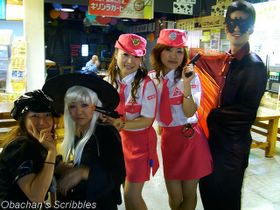

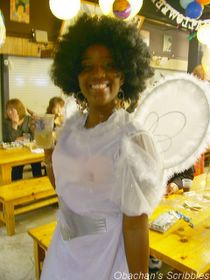
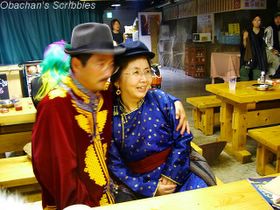

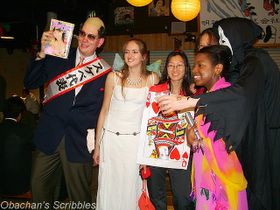
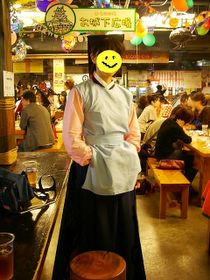
This is me. I made this costume myself.











This is me. I made this costume myself.
Wednesday, October 25, 2006
NOW WHAT'S NEXT?
Well, I guess writing about our autumn festival meant really something to me. I’m feeling so relieved, and somehow feeling a sense of closure… It was almost like having some kind of closure on my long-term issue related to my hometown. Something is telling me that it's not completely resolved but I can move onto a new chapter. After I uploaded the festival posts, I started feeling like throwing away some old stuff and making some room on the bookshelf, and now I’m in the middle of a big "purging project." It might include the cupboard in the kitchen, too.
Also, after celebrating a “Japanese” festival, it’s time for a Western one. My preparation for the coming Halloween party (Oct. 28th, I guess) has been started. I spent some time with my little sewing machine yesterday and I’m going to do so this afternoon, too ;) You’ll see what I’m going to dress up as pretty soon.
;)
Also, after celebrating a “Japanese” festival, it’s time for a Western one. My preparation for the coming Halloween party (Oct. 28th, I guess) has been started. I spent some time with my little sewing machine yesterday and I’m going to do so this afternoon, too ;) You’ll see what I’m going to dress up as pretty soon.
;)
Sunday, October 22, 2006
AUTUMN FESTIVAL IN MY HOMETOWN - MAIN FESTIVAL DAY -
-- October 15, 2006 --
(Some photos can be enlarged.)
The main festival day was a gorgeous, sunny day with a forecast of a daytime high of 28 C. It was the day that the gods enshrined at the Hachioji 八王子 shrine take a short trip to two other smaller shrines. Gods’ short trip seems to be a common practice of Shinto festivals in Japan. You can see parades with mikoshi (portable miniature shrines) and various attendants in traditional costumes walking through the town in many places throughout this country. Often they are very solemn, but our autumn festival’s parade called otabi 御旅 (the trip) is pretty athletic – almost triathlon-like. I’m not kidding. Yes, our mikoshi swims in the ocean. ;)
Often they are very solemn, but our autumn festival’s parade called otabi 御旅 (the trip) is pretty athletic – almost triathlon-like. I’m not kidding. Yes, our mikoshi swims in the ocean. ;)
It was a nice day, but the ocean was very rough because of a distant typhoon. So everyone was wondering if the mikoshi was going to go into the ocean this year or not. When I arrived at the shrine, some guys were giving a final check on the mikoshi.
The atmosphere of our festival was pretty laid-back, I would say, perhaps because this festival was not tourism-oriented but meant for the locals of this small town and their relatives who came back for this annual event. No food stalls came to this festival; you can easily assume that the food vendors could lose more money than they make. Here mikoshi were laid on the open stage of the shrine and various preparations were also done there, incl. dressing toninko boys, and visitors were able to take a real close look… THIS close. These photographers were taking shots of a toninko boy lying on the floor. (Looks like words are spreading among some amateur photographers recently that this festival is pretty photographer-friendly.)
perhaps because this festival was not tourism-oriented but meant for the locals of this small town and their relatives who came back for this annual event. No food stalls came to this festival; you can easily assume that the food vendors could lose more money than they make. Here mikoshi were laid on the open stage of the shrine and various preparations were also done there, incl. dressing toninko boys, and visitors were able to take a real close look… THIS close. These photographers were taking shots of a toninko boy lying on the floor. (Looks like words are spreading among some amateur photographers recently that this festival is pretty photographer-friendly.)
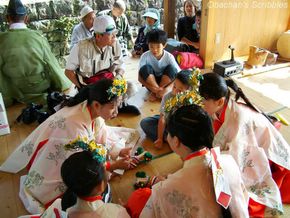 Maihime taking a break before the ceremony
Maihime taking a break before the ceremony
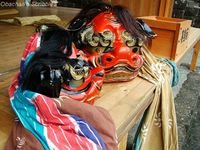
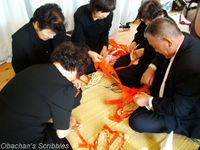
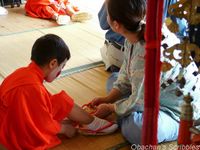 Touninko boys need to wear special straw sandals decorated with red strings. These elder people in formal black clothes took care of them.
Touninko boys need to wear special straw sandals decorated with red strings. These elder people in formal black clothes took care of them.

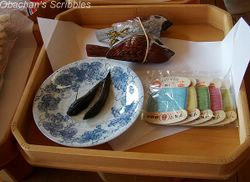
According to the printout given to festival staff, these fake sparrows and two small fish from the river are the symbol of indigenousness because they live in their birthplace throughout life.
The same ceremony as the previous day took place in front of the altar in the morning. Then attendants had a “departure feast” in a little hurry, and otabi started around noon.

 At the head of the parade were two guys with big bamboo brooms, sweeping and purifying the way for the sacred troop. Followed were tengu 天狗 (long-nosed goblin), touji-baa 杜氏婆 (sake-serving women), Ichi-san (shaman) with maihime 舞姫 (girl dancers), touninko 頭人子 boys, and other people carrying various offerings and ornaments… and mikoshi at the very end.
At the head of the parade were two guys with big bamboo brooms, sweeping and purifying the way for the sacred troop. Followed were tengu 天狗 (long-nosed goblin), touji-baa 杜氏婆 (sake-serving women), Ichi-san (shaman) with maihime 舞姫 (girl dancers), touninko 頭人子 boys, and other people carrying various offerings and ornaments… and mikoshi at the very end.
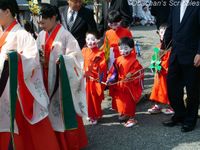
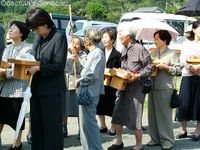 The touninko boys were considered to be still possessed by the gods. So they were surrounded by the straw rope and paper ornaments which make a "sacred space" inside.
The touninko boys were considered to be still possessed by the gods. So they were surrounded by the straw rope and paper ornaments which make a "sacred space" inside.
 The way our mikoshi proceed was a little different from other festivals I had seen. Instead of steadily moving forward, they stayed at one place for a while and moved sideways several times, from one side of the road to the other, just like a drunken man who can’t walk straight. Then they suddenly rushed forward for about one block. This pattern was repeated the whole way through accompanied by the songs and calls by the guys carrying them.
The way our mikoshi proceed was a little different from other festivals I had seen. Instead of steadily moving forward, they stayed at one place for a while and moved sideways several times, from one side of the road to the other, just like a drunken man who can’t walk straight. Then they suddenly rushed forward for about one block. This pattern was repeated the whole way through accompanied by the songs and calls by the guys carrying them.
No, not just songs and calls. Our generous and laid-back gods did not seem to care too much about politeness, and I heard some mikoshi-guys shouting things like “Gee! Don’t go too fast!” “OMG, I had too much beer!” “I’m too old for this!” “Hey! I’m not gonna do this next year. This is my last time!” (Oh, I’m 100% sure that he’ll be doing this again next year :)) The rest of the parade was always way ahead of the mikoshi, waiting for them to catch up.

Hey, is the mikoshi catching up?
----------
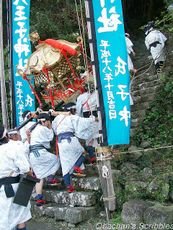 Now this is the first “athletic” part of the otabi: all the members HAD TO go up these steps to get to Nishimiya 西宮(West Shrine) for a ceremony. Yes, all the elder members AND the two mikoshi.
Now this is the first “athletic” part of the otabi: all the members HAD TO go up these steps to get to Nishimiya 西宮(West Shrine) for a ceremony. Yes, all the elder members AND the two mikoshi. 
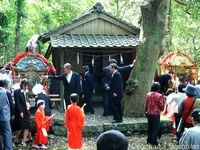
Nishi-miya was a tiny, very old shrine on a hilltop, surrounded by woods. It was such a hard work going up and down the steps, but the ceremony performed there looked so beautiful and almost “magical” in the shade of the woods. To me it looked like a very homey Shinto ceremony of the good old days when people were closer to the gods in nature and absolutely no commercialism was involved in the festival.
There, the participants and onlookers, including myself, were offered sake by touji-baa, the sake-serving women.
----------
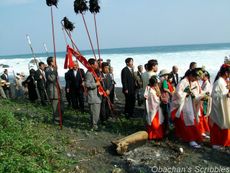 In this small town where the mountains and the ocean are close by, we must pay respect to both the god of the mountains and the god of the sea. After coming down the steps, the parade headed for the beach. I don’t know how common it is in Japan, but our otabi includes actually walking on the beach like this. Then everyone, including the two mikoshi, took a little break at another tiny shrine called Hama-miya 浜宮(Shrine at the beach).
In this small town where the mountains and the ocean are close by, we must pay respect to both the god of the mountains and the god of the sea. After coming down the steps, the parade headed for the beach. I don’t know how common it is in Japan, but our otabi includes actually walking on the beach like this. Then everyone, including the two mikoshi, took a little break at another tiny shrine called Hama-miya 浜宮(Shrine at the beach).
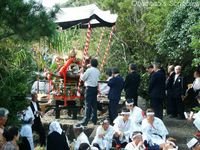
 There, the mikoshi were set on a big rock, and a couple of guys threw small rice cakes to the attendants and onlookers. Those who caught rice cakes were sharing them with people around so that as many participants as possible could get the blessing.
There, the mikoshi were set on a big rock, and a couple of guys threw small rice cakes to the attendants and onlookers. Those who caught rice cakes were sharing them with people around so that as many participants as possible could get the blessing.
 Also, an elder man walked around to give everyone rice cooked with chopped taro. I don't know exactly what it symbolizes, but it must have something to do with good harvest and/or good luck. Too bad I didn't get to eat this taro-mixed rice :(
Also, an elder man walked around to give everyone rice cooked with chopped taro. I don't know exactly what it symbolizes, but it must have something to do with good harvest and/or good luck. Too bad I didn't get to eat this taro-mixed rice :(
Now, after the little break at the Hama-miya, it was time for the most “athletic” part of this festival. The parade went back to the beach, where tomo-goshi, the black colored mikoshi, was supposed to go into the water!
 This is the reason why this festival is often listed as one of the “unusual festivals” in this prefecture. Even though there is little need to worry about the enshrined god catching a cold, ocean water is undoubtedly bad for the mikoshi itself -- especially when it is supposed to be passed down to descendents for years. But in our hometown, we keep performing this ritual. And now that the uniqueness of this custom is (relatively) widely known, attracting media attention and bunch of amateur photographers from in and outside the prefecture, the tomo-goshi seems to have no other choice but to go into the ocean as much as possible.
This is the reason why this festival is often listed as one of the “unusual festivals” in this prefecture. Even though there is little need to worry about the enshrined god catching a cold, ocean water is undoubtedly bad for the mikoshi itself -- especially when it is supposed to be passed down to descendents for years. But in our hometown, we keep performing this ritual. And now that the uniqueness of this custom is (relatively) widely known, attracting media attention and bunch of amateur photographers from in and outside the prefecture, the tomo-goshi seems to have no other choice but to go into the ocean as much as possible.
 Since the waves were too rough, the carriers of mikoshi seemed to have decided to go knee-deep only.(Usually they go further off-shore until the ocean water actually washes the tomo-goshi like this!)
Since the waves were too rough, the carriers of mikoshi seemed to have decided to go knee-deep only.(Usually they go further off-shore until the ocean water actually washes the tomo-goshi like this!)
But with the blue sky, blue ocean and breaking waves in the background, the scene looked really spectacular! So you think there must be a great religious importance behind this custom of taking the mikoshi into the ocean? I thought so, too, until I read the printout this year.
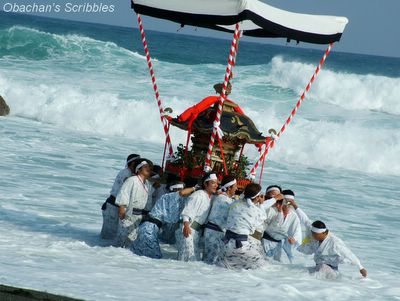 But the truth is, according to the quote from local history literature, the custom started in 1948 (some say 1946), not several hundreds years ago. This is how it started: After WWII, there spread a rumor that GHQ was going to ban all the Shinto festivals in Japan. Thinking that it could be the last time to celebrate, young mikoshi-carriers at that time felt like doing something outrageous and memorable. So they rushed into the ocean with the mikoshi, perhaps with the help of some sake-drinking. ;)
But the truth is, according to the quote from local history literature, the custom started in 1948 (some say 1946), not several hundreds years ago. This is how it started: After WWII, there spread a rumor that GHQ was going to ban all the Shinto festivals in Japan. Thinking that it could be the last time to celebrate, young mikoshi-carriers at that time felt like doing something outrageous and memorable. So they rushed into the ocean with the mikoshi, perhaps with the help of some sake-drinking. ;)
There was another strange custom that showed how “athletic” our ancestors were. At the very end of the gods’ short trip, when the two mikoshi came back to the main shrine, the mikoshi carriers rushed to let the mikoshi run onto the stage. A mikoshi itself is small enough to be set on the stage, but with people carrying it, it was much taller so it hit the roof of the shrine (not too hard, though). Then the guys stepped back to bring the mikoshi away from the stage once, and brought it back to the stage again to set it on the stage properly. The printout did not say anything about this ritual, but I wouldn’t be surprised if this was another recent addition which was also triggered by lots of sake-drinking. :)
----------
 When I went into the kitchen after coming back from otabi, the place was neatly cleaned up and all the food was properly packed. Mom went home to rest, and I stayed on to watch the tachiodori 太刀踊り(sword dance) again.
When I went into the kitchen after coming back from otabi, the place was neatly cleaned up and all the food was properly packed. Mom went home to rest, and I stayed on to watch the tachiodori 太刀踊り(sword dance) again.

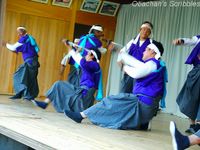
The dance started after these guys had enough rest. Yes, they were the same guys who carried the mikoshi. (Of course. There aren't too many young guys in my hometown.)
BTW, to me this Hachioji shrine looked pretty functional, though I cannot really compare because I haven't been to the backstage area of other shrines. There was a gray curtian between the altar chamber in the back and a stage area in front. I think it was there to be closed when the stage was being used for non-religious performances. The stage had a main curtain, so it was obvious that this place functioned as a local theater in olden days. And you can directly come into the altar or to the stage from the adjacent kitchen through separate sliding doors.

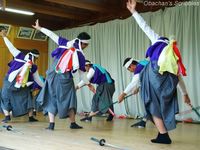

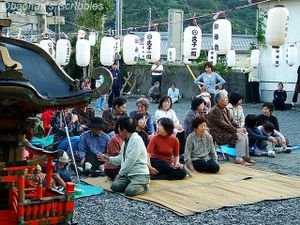 This is my favorite shot showing how laid-back and homey our festival was. Absolutely no food stalls. Most of the amateur photographers were gone by this time. It was just local folks and mikoshi sitting close together, watching the traditional dance performed by local men, both young and old.
This is my favorite shot showing how laid-back and homey our festival was. Absolutely no food stalls. Most of the amateur photographers were gone by this time. It was just local folks and mikoshi sitting close together, watching the traditional dance performed by local men, both young and old.
There are many famous Shinto festivals in Japan, but a scene like this could be rather rare. And to me a scene like this means so much.

So, this was my first experience of helping with the autumn festival in my hometown. Now I’m wondering…the next time I help with this festival, perhaps 30 years from now, would things be the same? Would there be the same mikoshi? Would there be more photographers then? Would there be boys to be touninko?
I left my hometown when I was twelve. I never felt that I was a part of this kind of “continuum” until now.
But I guess I am.
And after all, being part of a continuum is not really bad, I guess...
(Some photos can be enlarged.)
The main festival day was a gorgeous, sunny day with a forecast of a daytime high of 28 C. It was the day that the gods enshrined at the Hachioji 八王子 shrine take a short trip to two other smaller shrines. Gods’ short trip seems to be a common practice of Shinto festivals in Japan. You can see parades with mikoshi (portable miniature shrines) and various attendants in traditional costumes walking through the town in many places throughout this country.
 Often they are very solemn, but our autumn festival’s parade called otabi 御旅 (the trip) is pretty athletic – almost triathlon-like. I’m not kidding. Yes, our mikoshi swims in the ocean. ;)
Often they are very solemn, but our autumn festival’s parade called otabi 御旅 (the trip) is pretty athletic – almost triathlon-like. I’m not kidding. Yes, our mikoshi swims in the ocean. ;)It was a nice day, but the ocean was very rough because of a distant typhoon. So everyone was wondering if the mikoshi was going to go into the ocean this year or not. When I arrived at the shrine, some guys were giving a final check on the mikoshi.
The atmosphere of our festival was pretty laid-back, I would say,
 perhaps because this festival was not tourism-oriented but meant for the locals of this small town and their relatives who came back for this annual event. No food stalls came to this festival; you can easily assume that the food vendors could lose more money than they make. Here mikoshi were laid on the open stage of the shrine and various preparations were also done there, incl. dressing toninko boys, and visitors were able to take a real close look… THIS close. These photographers were taking shots of a toninko boy lying on the floor. (Looks like words are spreading among some amateur photographers recently that this festival is pretty photographer-friendly.)
perhaps because this festival was not tourism-oriented but meant for the locals of this small town and their relatives who came back for this annual event. No food stalls came to this festival; you can easily assume that the food vendors could lose more money than they make. Here mikoshi were laid on the open stage of the shrine and various preparations were also done there, incl. dressing toninko boys, and visitors were able to take a real close look… THIS close. These photographers were taking shots of a toninko boy lying on the floor. (Looks like words are spreading among some amateur photographers recently that this festival is pretty photographer-friendly.) Maihime taking a break before the ceremony
Maihime taking a break before the ceremony
Shishimai (lion dance) outfit waiting for the departure

 Touninko boys need to wear special straw sandals decorated with red strings. These elder people in formal black clothes took care of them.
Touninko boys need to wear special straw sandals decorated with red strings. These elder people in formal black clothes took care of them.

Food offerings to be taken with the otabi
According to the printout given to festival staff, these fake sparrows and two small fish from the river are the symbol of indigenousness because they live in their birthplace throughout life.
The same ceremony as the previous day took place in front of the altar in the morning. Then attendants had a “departure feast” in a little hurry, and otabi started around noon.

 At the head of the parade were two guys with big bamboo brooms, sweeping and purifying the way for the sacred troop. Followed were tengu 天狗 (long-nosed goblin), touji-baa 杜氏婆 (sake-serving women), Ichi-san (shaman) with maihime 舞姫 (girl dancers), touninko 頭人子 boys, and other people carrying various offerings and ornaments… and mikoshi at the very end.
At the head of the parade were two guys with big bamboo brooms, sweeping and purifying the way for the sacred troop. Followed were tengu 天狗 (long-nosed goblin), touji-baa 杜氏婆 (sake-serving women), Ichi-san (shaman) with maihime 舞姫 (girl dancers), touninko 頭人子 boys, and other people carrying various offerings and ornaments… and mikoshi at the very end.
 The touninko boys were considered to be still possessed by the gods. So they were surrounded by the straw rope and paper ornaments which make a "sacred space" inside.
The touninko boys were considered to be still possessed by the gods. So they were surrounded by the straw rope and paper ornaments which make a "sacred space" inside. The way our mikoshi proceed was a little different from other festivals I had seen. Instead of steadily moving forward, they stayed at one place for a while and moved sideways several times, from one side of the road to the other, just like a drunken man who can’t walk straight. Then they suddenly rushed forward for about one block. This pattern was repeated the whole way through accompanied by the songs and calls by the guys carrying them.
The way our mikoshi proceed was a little different from other festivals I had seen. Instead of steadily moving forward, they stayed at one place for a while and moved sideways several times, from one side of the road to the other, just like a drunken man who can’t walk straight. Then they suddenly rushed forward for about one block. This pattern was repeated the whole way through accompanied by the songs and calls by the guys carrying them.No, not just songs and calls. Our generous and laid-back gods did not seem to care too much about politeness, and I heard some mikoshi-guys shouting things like “Gee! Don’t go too fast!” “OMG, I had too much beer!” “I’m too old for this!” “Hey! I’m not gonna do this next year. This is my last time!” (Oh, I’m 100% sure that he’ll be doing this again next year :)) The rest of the parade was always way ahead of the mikoshi, waiting for them to catch up.

Hey, is the mikoshi catching up?
----------
 Now this is the first “athletic” part of the otabi: all the members HAD TO go up these steps to get to Nishimiya 西宮(West Shrine) for a ceremony. Yes, all the elder members AND the two mikoshi.
Now this is the first “athletic” part of the otabi: all the members HAD TO go up these steps to get to Nishimiya 西宮(West Shrine) for a ceremony. Yes, all the elder members AND the two mikoshi. 

Actually, these steps were steeper than they look in these photos. The awning of mikoshi had to be removed before going up the steps so that they can go through the small gate of the shrine.
Nishi-miya was a tiny, very old shrine on a hilltop, surrounded by woods. It was such a hard work going up and down the steps, but the ceremony performed there looked so beautiful and almost “magical” in the shade of the woods. To me it looked like a very homey Shinto ceremony of the good old days when people were closer to the gods in nature and absolutely no commercialism was involved in the festival.
There, the participants and onlookers, including myself, were offered sake by touji-baa, the sake-serving women.
----------
 In this small town where the mountains and the ocean are close by, we must pay respect to both the god of the mountains and the god of the sea. After coming down the steps, the parade headed for the beach. I don’t know how common it is in Japan, but our otabi includes actually walking on the beach like this. Then everyone, including the two mikoshi, took a little break at another tiny shrine called Hama-miya 浜宮(Shrine at the beach).
In this small town where the mountains and the ocean are close by, we must pay respect to both the god of the mountains and the god of the sea. After coming down the steps, the parade headed for the beach. I don’t know how common it is in Japan, but our otabi includes actually walking on the beach like this. Then everyone, including the two mikoshi, took a little break at another tiny shrine called Hama-miya 浜宮(Shrine at the beach).
 There, the mikoshi were set on a big rock, and a couple of guys threw small rice cakes to the attendants and onlookers. Those who caught rice cakes were sharing them with people around so that as many participants as possible could get the blessing.
There, the mikoshi were set on a big rock, and a couple of guys threw small rice cakes to the attendants and onlookers. Those who caught rice cakes were sharing them with people around so that as many participants as possible could get the blessing. Also, an elder man walked around to give everyone rice cooked with chopped taro. I don't know exactly what it symbolizes, but it must have something to do with good harvest and/or good luck. Too bad I didn't get to eat this taro-mixed rice :(
Also, an elder man walked around to give everyone rice cooked with chopped taro. I don't know exactly what it symbolizes, but it must have something to do with good harvest and/or good luck. Too bad I didn't get to eat this taro-mixed rice :(Now, after the little break at the Hama-miya, it was time for the most “athletic” part of this festival. The parade went back to the beach, where tomo-goshi, the black colored mikoshi, was supposed to go into the water!
 This is the reason why this festival is often listed as one of the “unusual festivals” in this prefecture. Even though there is little need to worry about the enshrined god catching a cold, ocean water is undoubtedly bad for the mikoshi itself -- especially when it is supposed to be passed down to descendents for years. But in our hometown, we keep performing this ritual. And now that the uniqueness of this custom is (relatively) widely known, attracting media attention and bunch of amateur photographers from in and outside the prefecture, the tomo-goshi seems to have no other choice but to go into the ocean as much as possible.
This is the reason why this festival is often listed as one of the “unusual festivals” in this prefecture. Even though there is little need to worry about the enshrined god catching a cold, ocean water is undoubtedly bad for the mikoshi itself -- especially when it is supposed to be passed down to descendents for years. But in our hometown, we keep performing this ritual. And now that the uniqueness of this custom is (relatively) widely known, attracting media attention and bunch of amateur photographers from in and outside the prefecture, the tomo-goshi seems to have no other choice but to go into the ocean as much as possible. Since the waves were too rough, the carriers of mikoshi seemed to have decided to go knee-deep only.(Usually they go further off-shore until the ocean water actually washes the tomo-goshi like this!)
Since the waves were too rough, the carriers of mikoshi seemed to have decided to go knee-deep only.(Usually they go further off-shore until the ocean water actually washes the tomo-goshi like this!)But with the blue sky, blue ocean and breaking waves in the background, the scene looked really spectacular! So you think there must be a great religious importance behind this custom of taking the mikoshi into the ocean? I thought so, too, until I read the printout this year.
 But the truth is, according to the quote from local history literature, the custom started in 1948 (some say 1946), not several hundreds years ago. This is how it started: After WWII, there spread a rumor that GHQ was going to ban all the Shinto festivals in Japan. Thinking that it could be the last time to celebrate, young mikoshi-carriers at that time felt like doing something outrageous and memorable. So they rushed into the ocean with the mikoshi, perhaps with the help of some sake-drinking. ;)
But the truth is, according to the quote from local history literature, the custom started in 1948 (some say 1946), not several hundreds years ago. This is how it started: After WWII, there spread a rumor that GHQ was going to ban all the Shinto festivals in Japan. Thinking that it could be the last time to celebrate, young mikoshi-carriers at that time felt like doing something outrageous and memorable. So they rushed into the ocean with the mikoshi, perhaps with the help of some sake-drinking. ;)There was another strange custom that showed how “athletic” our ancestors were. At the very end of the gods’ short trip, when the two mikoshi came back to the main shrine, the mikoshi carriers rushed to let the mikoshi run onto the stage. A mikoshi itself is small enough to be set on the stage, but with people carrying it, it was much taller so it hit the roof of the shrine (not too hard, though). Then the guys stepped back to bring the mikoshi away from the stage once, and brought it back to the stage again to set it on the stage properly. The printout did not say anything about this ritual, but I wouldn’t be surprised if this was another recent addition which was also triggered by lots of sake-drinking. :)
----------
 When I went into the kitchen after coming back from otabi, the place was neatly cleaned up and all the food was properly packed. Mom went home to rest, and I stayed on to watch the tachiodori 太刀踊り(sword dance) again.
When I went into the kitchen after coming back from otabi, the place was neatly cleaned up and all the food was properly packed. Mom went home to rest, and I stayed on to watch the tachiodori 太刀踊り(sword dance) again.

The dance started after these guys had enough rest. Yes, they were the same guys who carried the mikoshi. (Of course. There aren't too many young guys in my hometown.)
BTW, to me this Hachioji shrine looked pretty functional, though I cannot really compare because I haven't been to the backstage area of other shrines. There was a gray curtian between the altar chamber in the back and a stage area in front. I think it was there to be closed when the stage was being used for non-religious performances. The stage had a main curtain, so it was obvious that this place functioned as a local theater in olden days. And you can directly come into the altar or to the stage from the adjacent kitchen through separate sliding doors.



Tachiodori is accompanied by songs and the beat of wooden clappers only.
 This is my favorite shot showing how laid-back and homey our festival was. Absolutely no food stalls. Most of the amateur photographers were gone by this time. It was just local folks and mikoshi sitting close together, watching the traditional dance performed by local men, both young and old.
This is my favorite shot showing how laid-back and homey our festival was. Absolutely no food stalls. Most of the amateur photographers were gone by this time. It was just local folks and mikoshi sitting close together, watching the traditional dance performed by local men, both young and old.There are many famous Shinto festivals in Japan, but a scene like this could be rather rare. And to me a scene like this means so much.

Taking down the decorations
So, this was my first experience of helping with the autumn festival in my hometown. Now I’m wondering…the next time I help with this festival, perhaps 30 years from now, would things be the same? Would there be the same mikoshi? Would there be more photographers then? Would there be boys to be touninko?
I left my hometown when I was twelve. I never felt that I was a part of this kind of “continuum” until now.
But I guess I am.
And after all, being part of a continuum is not really bad, I guess...
Photos in this post by obachan -- All rights reserved
この記事内の写真については、一切の無断転載を禁じます
Categories: Kochi
この記事内の写真については、一切の無断転載を禁じます
Friday, October 20, 2006
AUTUMN FESTIVAL IN MY HOMETOWN - FESTIVAL EVE -
-- October 14, 2006 --
(Some photos can be enlarged.)
On Saturday, October 14th, I took an early bus to my hometown to help with the cooking for the festival. At around 10:30 am, I was walking toward the old shrine at where I played hide-and-seek in my childhood. I haven’t been to this part of town since my elementary school days. When you visit your hometown after living somewhere else for about 20 years, I guess you usually witness the facilities there being larger and modernized. Well, not in my hometown (and perhaps in many other underpopulated regions in Japan, too). The candy store I went often as a kid was gone. The empty clinic next to the shrine was being used for other purposes – they never had a doctor there since my childhood. And the elementary school I attended was officially closed this year.
But the shrine looked the same as it was in my childhood, and looked pretty lively with the local folks here and there preparing for the festival. In the kitchen, four touya’s wives (incl. my mom) welcomed me and I was immediately led to the deep-frying pot.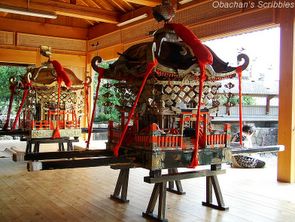 (For the details of our cooking adventures, click here.)
(For the details of our cooking adventures, click here.)
On the “stage” of the shrine, two mikoshi (portable miniature shrines) were quietly waiting. The gold one is the main mikoshi called hon-goshi, and the black one is an accompanying one called tomo-goshi. This black one is probably one of the most abused mikoshi in Japan, I suppose. You’ll see what I mean. It is because of the unique rituals of our autumn festival.
One of the uniqueness of our festival is the boys called touninko 頭人子. Early in the afternoon, two old ladies started putting make-up on the four boys chosen for this special role this year. Shinto festivals with toninko seem to be rather rare, and our toninko could be the funniest looking ones in Japan, honestly. I don’t know the reason behind this strange make-up, but it sure makes them look “extraordinary.”

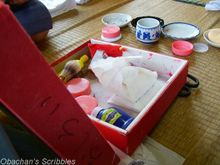
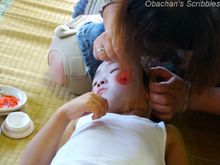
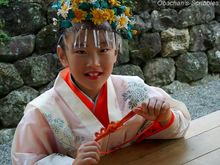 I don't know who dressed the maihime 舞姫 girls, but they were ready way before the boys were.
I don't know who dressed the maihime 舞姫 girls, but they were ready way before the boys were.
The formal Shinto ritual of Yoimiya 宵宮 (ceremony on the eve of the festival) started at around 5 pm in front of the altar behind these two mikoshi.
 During the ritual, the touninko boys sit at the altar like this. It is believed that the gods come down onto the boys and possess their bodies. And when toninko boys look drowsy while the priest is saying the prayer, it is considered as the sign of god(s) coming into their bodies. How nice! :D BTW, these sacred boys receive pretty down-to-earth rewards after the ritual. Before they go home, each of them receives a bag full of sweets. I know it because my mom and I spent good amount of time at the supermarket the weekend before, buying sweets for them. Mom was so worried that the boys may not like what she bought, and almost going paranoid.
During the ritual, the touninko boys sit at the altar like this. It is believed that the gods come down onto the boys and possess their bodies. And when toninko boys look drowsy while the priest is saying the prayer, it is considered as the sign of god(s) coming into their bodies. How nice! :D BTW, these sacred boys receive pretty down-to-earth rewards after the ritual. Before they go home, each of them receives a bag full of sweets. I know it because my mom and I spent good amount of time at the supermarket the weekend before, buying sweets for them. Mom was so worried that the boys may not like what she bought, and almost going paranoid.
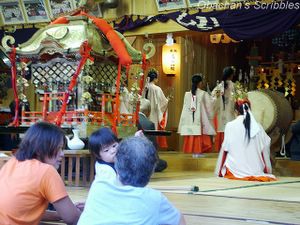
The prayer was followed by the dance by Ichi-san (shaman) and then by maihime (girl dancers). Maihime are chosen from local young girls every year, but Ichi-san is a female child of the designated shaman’s family. This ichi-san told me that if no female child was born in the family, it was OK to skip one generation and pass the shaman's position from a grandmother to her granddaughter. Maihime’s dance seemed pretty similar to the dance I saw at another Shinto festival last year.
After the ritual, it was the time for a big feast (I mean, big for this small shrine). I really loved to see the boys in the regular clothes but still wearing the toninko make-up, and maihime wearing aprons to cover the costumes (because they have to be returned to the shrine after the festival).
Later in the evening, tachiodori 太刀踊り (sword dance) was performed on the stage of the shrine. This dance, designated as an intangible cultural asset by the prefecture, is performed by male dancers only. When I was an elementary school kid, I saw some boys in my class taking part in the dance, and felt so envious.
What surprised us at the very end was an unexpected shower. The festival staff rushed to the flags at the gate of the shrine to take them down. I was more worried about the paper lanterns with electric bulbs inside, but luckily, nothing broke. The staff left the lanterns on the stage that was partly wet from the shower, and went home. Everyone was so tired, but we still had a big day left.
Having to get up extremely early next morning, mom and I didn't even stay up to watch Dae Jang Geum on TV.
To be cont'd...
(Some photos can be enlarged.)
On Saturday, October 14th, I took an early bus to my hometown to help with the cooking for the festival. At around 10:30 am, I was walking toward the old shrine at where I played hide-and-seek in my childhood. I haven’t been to this part of town since my elementary school days. When you visit your hometown after living somewhere else for about 20 years, I guess you usually witness the facilities there being larger and modernized. Well, not in my hometown (and perhaps in many other underpopulated regions in Japan, too). The candy store I went often as a kid was gone. The empty clinic next to the shrine was being used for other purposes – they never had a doctor there since my childhood. And the elementary school I attended was officially closed this year.
But the shrine looked the same as it was in my childhood, and looked pretty lively with the local folks here and there preparing for the festival. In the kitchen, four touya’s wives (incl. my mom) welcomed me and I was immediately led to the deep-frying pot.
 (For the details of our cooking adventures, click here.)
(For the details of our cooking adventures, click here.)On the “stage” of the shrine, two mikoshi (portable miniature shrines) were quietly waiting. The gold one is the main mikoshi called hon-goshi, and the black one is an accompanying one called tomo-goshi. This black one is probably one of the most abused mikoshi in Japan, I suppose. You’ll see what I mean. It is because of the unique rituals of our autumn festival.
One of the uniqueness of our festival is the boys called touninko 頭人子. Early in the afternoon, two old ladies started putting make-up on the four boys chosen for this special role this year. Shinto festivals with toninko seem to be rather rare, and our toninko could be the funniest looking ones in Japan, honestly. I don’t know the reason behind this strange make-up, but it sure makes them look “extraordinary.”



I assume the color red is associated with god's power (that chases evels away), and the white folded paper glued near the boys' ears symbolizes the sacredness.
 I don't know who dressed the maihime 舞姫 girls, but they were ready way before the boys were.
I don't know who dressed the maihime 舞姫 girls, but they were ready way before the boys were.The formal Shinto ritual of Yoimiya 宵宮 (ceremony on the eve of the festival) started at around 5 pm in front of the altar behind these two mikoshi.
 During the ritual, the touninko boys sit at the altar like this. It is believed that the gods come down onto the boys and possess their bodies. And when toninko boys look drowsy while the priest is saying the prayer, it is considered as the sign of god(s) coming into their bodies. How nice! :D BTW, these sacred boys receive pretty down-to-earth rewards after the ritual. Before they go home, each of them receives a bag full of sweets. I know it because my mom and I spent good amount of time at the supermarket the weekend before, buying sweets for them. Mom was so worried that the boys may not like what she bought, and almost going paranoid.
During the ritual, the touninko boys sit at the altar like this. It is believed that the gods come down onto the boys and possess their bodies. And when toninko boys look drowsy while the priest is saying the prayer, it is considered as the sign of god(s) coming into their bodies. How nice! :D BTW, these sacred boys receive pretty down-to-earth rewards after the ritual. Before they go home, each of them receives a bag full of sweets. I know it because my mom and I spent good amount of time at the supermarket the weekend before, buying sweets for them. Mom was so worried that the boys may not like what she bought, and almost going paranoid.
The prayer was followed by the dance by Ichi-san (shaman) and then by maihime (girl dancers). Maihime are chosen from local young girls every year, but Ichi-san is a female child of the designated shaman’s family. This ichi-san told me that if no female child was born in the family, it was OK to skip one generation and pass the shaman's position from a grandmother to her granddaughter. Maihime’s dance seemed pretty similar to the dance I saw at another Shinto festival last year.
After the ritual, it was the time for a big feast (I mean, big for this small shrine). I really loved to see the boys in the regular clothes but still wearing the toninko make-up, and maihime wearing aprons to cover the costumes (because they have to be returned to the shrine after the festival).
Later in the evening, tachiodori 太刀踊り (sword dance) was performed on the stage of the shrine. This dance, designated as an intangible cultural asset by the prefecture, is performed by male dancers only. When I was an elementary school kid, I saw some boys in my class taking part in the dance, and felt so envious.
What surprised us at the very end was an unexpected shower. The festival staff rushed to the flags at the gate of the shrine to take them down. I was more worried about the paper lanterns with electric bulbs inside, but luckily, nothing broke. The staff left the lanterns on the stage that was partly wet from the shower, and went home. Everyone was so tired, but we still had a big day left.
Having to get up extremely early next morning, mom and I didn't even stay up to watch Dae Jang Geum on TV.
To be cont'd...
Photos in this post by obachan -- All rights reserved
この記事内の写真については、一切の無断転載を禁じます
Categories: Kochi
この記事内の写真については、一切の無断転載を禁じます



